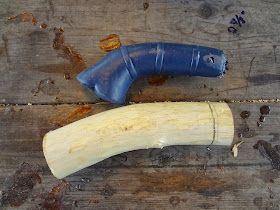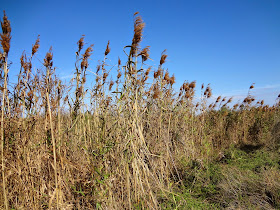The traditional Malaysian parang comes with a wooden
handle. The handle is sometimes sloped
with a flare or bulbous end that helps maintain control of the tool when
chopping. Some handles are well made
while others are crude and poorly conceived.
Plastic handles have replaced wooden handles in many models—particularly
those found in hardware stores and other shops.
Bidor Parang with plastic handle
As detailed in the previous post the handhold section of the
plastic handle is about 3 1/8
inches. The overall handle length is 5 3/8 inches. Using my Bidor parang for general brush
cleaning and assorted bushcraft endeavors around the cabin proved uncomfortable
as a result of the small handle and I soon relinquished the parang to storage. After a while, however, I decided to replace
the plastic handle with a wooden handle that mimics the handles I make for my
Woods Roamer knives and larger choppers.
The new handle is made from mesquite. It measures 6 5/8 inches long and incorporates a 3/8 inch long copper ferrule at the
fore-section to support the parang’s stick tang at its widest part. The handle’s circumference increases from
fore to aft. This allows the user to choke
the handle nearest the blade when performing detailed woodcarving tasks. The end-swell helps control the knife during
light chopping. I also rounded the steel
nearest the handle to allow the user to grab that section more
comfortably. (Refer to photo) Most of my Woods Roamer knife handles range
about six-inches long but I decided to go a bit more on this knife My biggest concern, as noted in the previous
post, is the short and somewhat flimsy stick tang used on these parangs. Honestly, I don’t believe I’d want to trust
my life to this parang. The tang,
measuring only 2 7/8 inches long, is
simply too insubstantial for any genuine survival use. We should remember, however, that Malaysian
parangs are made by villagers or in small shops and sell for a few dollars, a
price well within the affordable range for rural customers. Malaysian parangs were not designed for foreign
markets nor were they intended to suit the needs of urban bushcrafters or
survivalists. They are inexpensive,
quickly replaceable tools made from recycled steel and as such fit the needs of
Malaysians—if not the needs of bushcrafters who end up paying from five to ten
times (in the US or Europe) what the knife is actually worth.
Allow me to analyze the parang’s stick tang and its typical handle
a bit more. The stick tang is placed
within the wooden handle via a hole drilled and filed directly into the
wood. As a sidebar let me add that on a
YouTube video a Malaysian acquires a piece of green wood and then begins
tapping a sharpened stick tang into the wood driving the sharp tang downward
until it is fully inserted into the wood.
Apparently no cross-pin is used to help hold the tang in place. The wooden handle (with the blade now
attached) is then placed next to a fire to allow the wood to dry. I think any knifemaker will look at that
video and shake his head. First, as the wood
dries around the stick tang it will shrink in size and thus pull away from the tang. This will loosen the tang within the
handle. Second, placing the blade so
close to a fire creates the potential for destroying the steel’s temper
particularly as heat travels up the blade towards the cutting edge. In other words, this video serves as a good
example of people doing things with little to no knowledge of either wood or steel
dynamics. Now let’s continue: If you
drill a hole into a piece of wood you are weakening the wood’s strength around
the hole. The extent to which you weaken
the wood depends on how deep the hole is drilled. As an example, a short tang, as seen on Malaysian
parangs, drilled under three inches does less damage than a five or six inch
tang might create. In that sense, the
short stick tang, as seen on these parangs, works okay as long as we
acknowledge that the concept is a compromise.
In other words, it works given the needs of those who use it. If one intends to use a longer stick tang
then I suggest instead of drilling a hole, one should cut the handle in two and
then carefully inlet the tang into both sides (or scales) and then pin and
epoxy the three parts (two scales and tang) back together. This makes for a stronger handle since the tang
is mated firmly (via inletting) into the wood with no void of any sort. Note that the hole drilled into the wood to
insert the stick tang in Malaysian parangs is often filled with epoxy. This is good but not necessarily as strong as
direct contact with wood as seen in proper inletting. Let me add that one should avoid the urge to
simply drill a large hole into a piece of wood in order to drop the stick tang
into the hole and then fill the gap with epoxy.
That will not make for a strong core even when pinned.
I triple pinned this tang.
One pin is underneath the copper ferrule and two other pins are directly
behind the ferrule as seen in the above photograph.
When I see pictures of Malaysian parangs I come to one of two
conclusions. Either I’ll think, “This
fellow knows knife design,” or I’ll think, “This guy is a novice.” I saw a post a few years back where a guy
makes a handle for his parang. I liked
the way he carved the handle with his Mora knife but otherwise the finished
product failed ergonomically. I think
the man even admitted that fact in a later post. Good for him.
First of all, if you want to make a new handle for a parang you should
find a branch with a natural curve and start your handle from there. Don’t simply get a chunk of wood or a big,
round branch and attempt to make your handle—unless the wood is big enough that
you have enough to work with to form a sloping handle. Also, some of these Malaysian parangs have a
bulbous belly that despite its intentions crowds the hand, interferes with chopping
and does little to keep the blade controlled.
If you want to see how a handle ought to be designed then please refer
to the handle I made for this parang.
There is nothing original with this handle. As mentioned in the previous Part One section
of this post I am simply copying the handle of the great Colt Peacemaker that
in my opinion is the most comfortable
handle ever designed on any “working tool” bar none. The Colt’s handle rolls with the recoil and
thus does not bury the grip into the hand.
The handle on this re-worked parang does the same thing.
So there you have it, folks.
Will I use this parang now? Of
course, I will. But I will use it
knowing its limitations. I am amazed at
the videos I see where people take parangs even kukris and start chopping huge
branches. Hint: Use an axe! The parang is designed for rainforest use
especially in places with bamboo. It works
quite well in the desert Southwest and Brushlands as a bushcraft tool. Machetes with longer 24-inch blades work as
well if not better most of the time. The
parang’s short tang is decidedly disconcerting and every time I examine my
Bidor parang I use my X-ray vision to see that tiny little bitty tang underneath
and I think, “Hmmm, I wonder.”


















